Optimizing Tesco's Supply Chain: The Impact of IT Technologies
VerifiedAdded on 2023/06/12
|12
|2445
|351
Report
AI Summary
This report delves into Tesco's supply chain management, emphasizing the pivotal role of information technology in optimizing operations. It highlights how advancements, particularly RFID technology, enhance inventory tracking, reduce errors, and improve overall efficiency. The report explores the cognitive hierarchy model within the supply chain, showcasing how data from RFID systems informs decision-making across various stages, including suppliers, manufacturers, and retailers. Furthermore, it examines the factors influencing supply chain relationships, such as trust and information sharing, and concludes that the strategic adoption of IT innovations like RFID is crucial for maintaining a competitive edge in the rapidly evolving global market. Desklib offers a wealth of similar solved assignments and past papers for students seeking to deepen their understanding of business and technology.
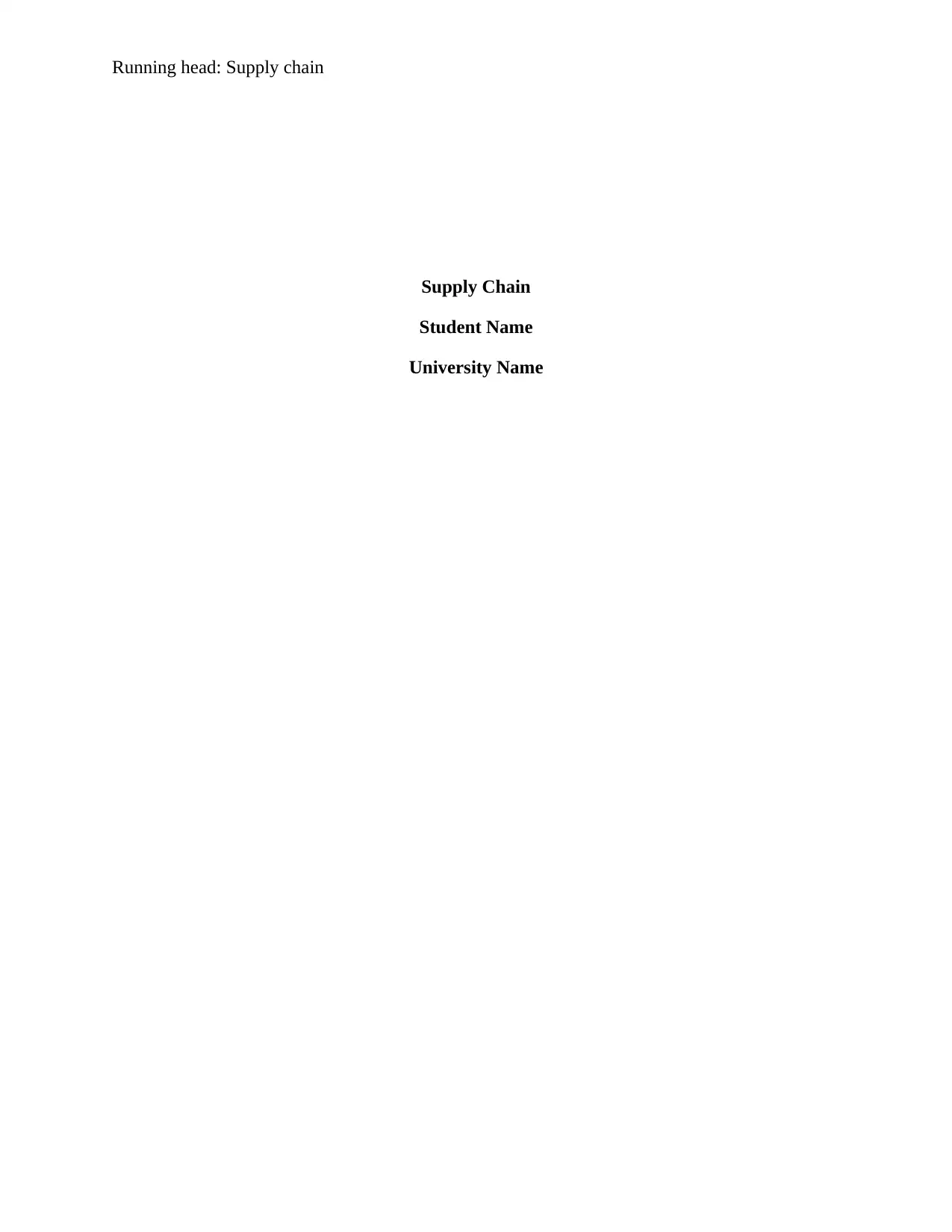
Running head: Supply chain
Supply Chain
Student Name
University Name
Supply Chain
Student Name
University Name
Paraphrase This Document
Need a fresh take? Get an instant paraphrase of this document with our AI Paraphraser
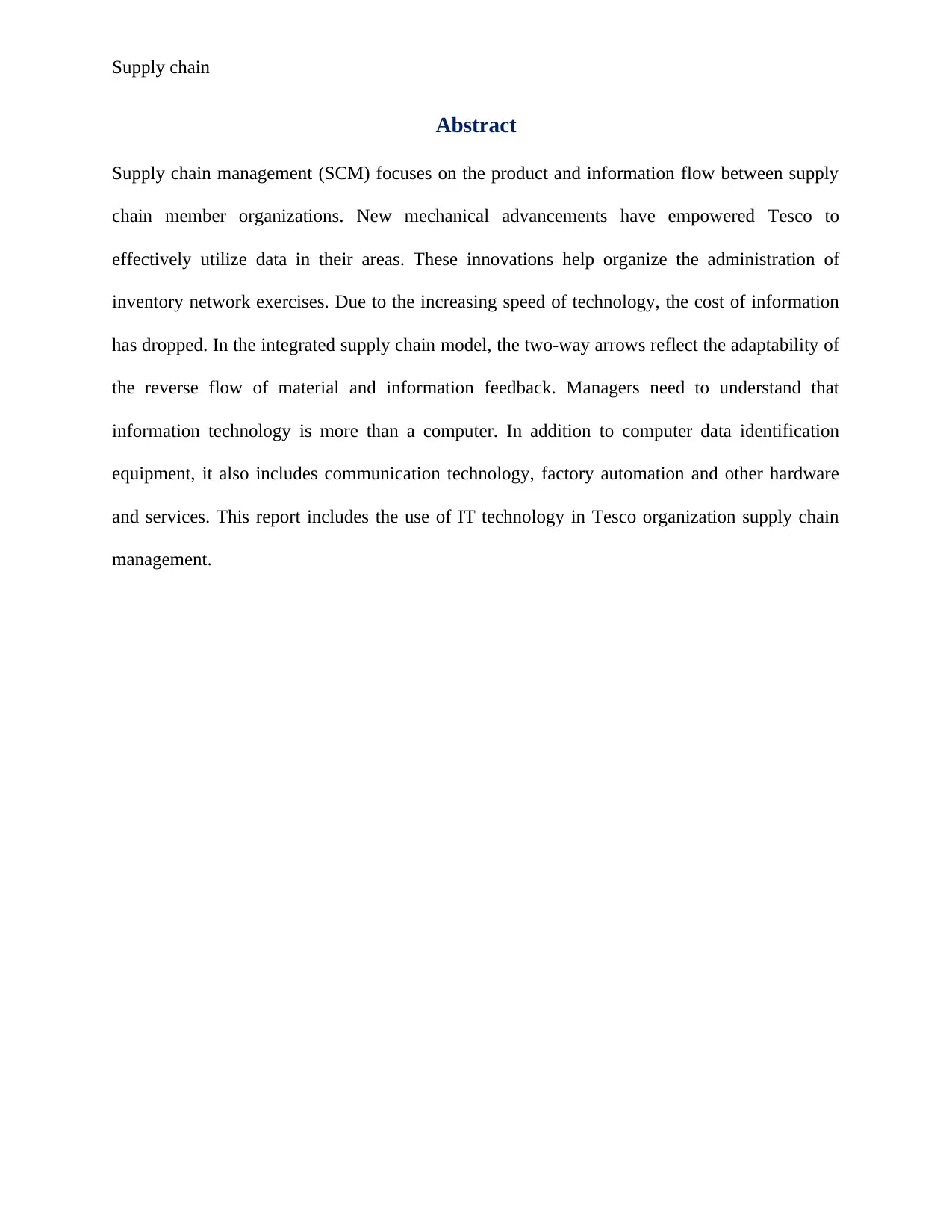
Supply chain
Abstract
Supply chain management (SCM) focuses on the product and information flow between supply
chain member organizations. New mechanical advancements have empowered Tesco to
effectively utilize data in their areas. These innovations help organize the administration of
inventory network exercises. Due to the increasing speed of technology, the cost of information
has dropped. In the integrated supply chain model, the two-way arrows reflect the adaptability of
the reverse flow of material and information feedback. Managers need to understand that
information technology is more than a computer. In addition to computer data identification
equipment, it also includes communication technology, factory automation and other hardware
and services. This report includes the use of IT technology in Tesco organization supply chain
management.
Abstract
Supply chain management (SCM) focuses on the product and information flow between supply
chain member organizations. New mechanical advancements have empowered Tesco to
effectively utilize data in their areas. These innovations help organize the administration of
inventory network exercises. Due to the increasing speed of technology, the cost of information
has dropped. In the integrated supply chain model, the two-way arrows reflect the adaptability of
the reverse flow of material and information feedback. Managers need to understand that
information technology is more than a computer. In addition to computer data identification
equipment, it also includes communication technology, factory automation and other hardware
and services. This report includes the use of IT technology in Tesco organization supply chain
management.
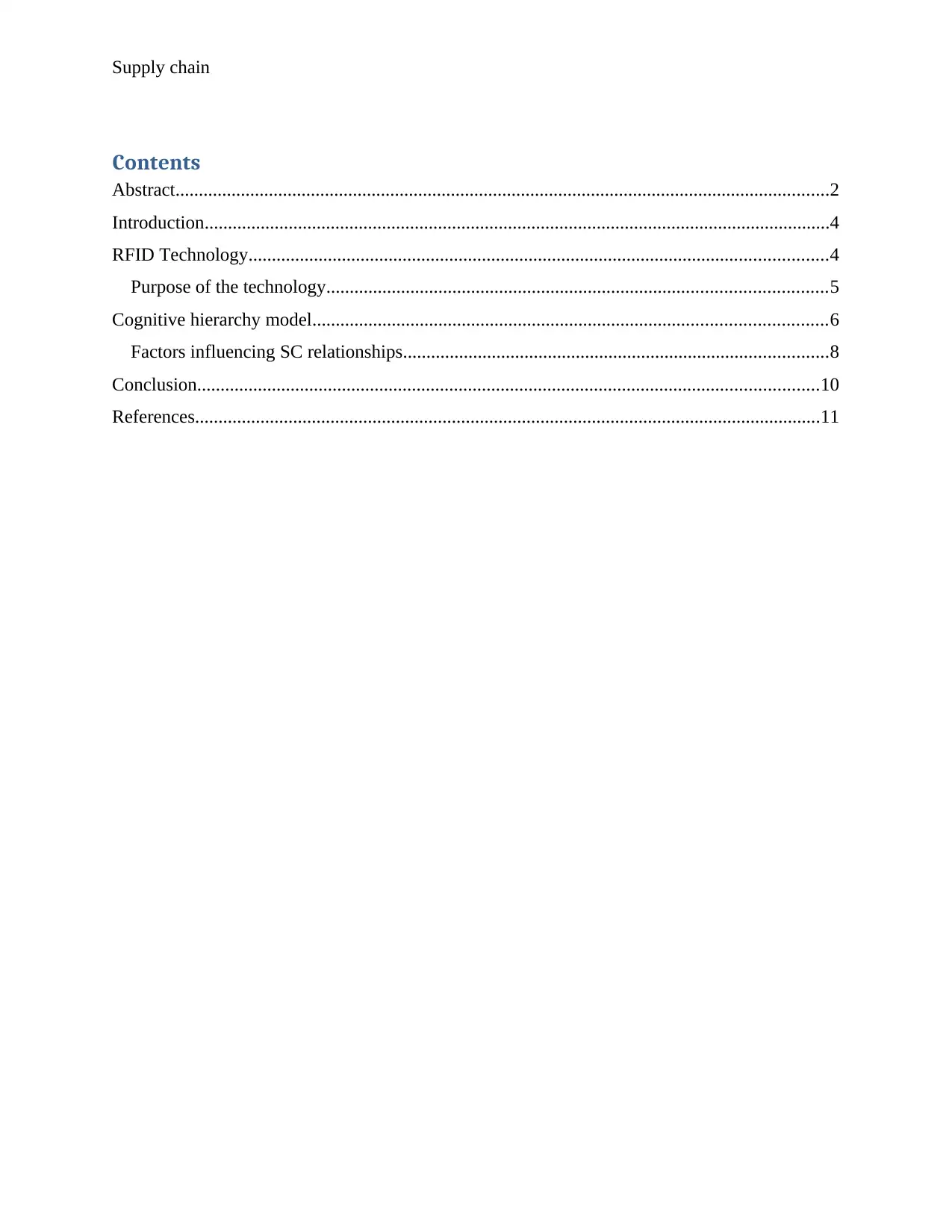
Supply chain
Contents
Abstract............................................................................................................................................2
Introduction......................................................................................................................................4
RFID Technology............................................................................................................................4
Purpose of the technology...........................................................................................................5
Cognitive hierarchy model..............................................................................................................6
Factors influencing SC relationships...........................................................................................8
Conclusion.....................................................................................................................................10
References......................................................................................................................................11
Contents
Abstract............................................................................................................................................2
Introduction......................................................................................................................................4
RFID Technology............................................................................................................................4
Purpose of the technology...........................................................................................................5
Cognitive hierarchy model..............................................................................................................6
Factors influencing SC relationships...........................................................................................8
Conclusion.....................................................................................................................................10
References......................................................................................................................................11
⊘ This is a preview!⊘
Do you want full access?
Subscribe today to unlock all pages.

Trusted by 1+ million students worldwide

Supply chain
Introduction
Data is a key inventory network driver since it can go about as cement, enabling different drivers
to cooperate with the objective of making a total composed production network. Data influences
the supply to anchor obvious to administrators. With deceivability, chiefs can settle on choices to
enhance inventory network execution. Managers of Tesco must know how to collect and
analyze information. This is the place data innovation becomes possibly the most important
factor, because information technology consists of software, hardware, and personnel in the
entire information system and is responsible for collecting, analyzing, and executing information.
Therefore, organizations need to connect and be able to share information in real time and in real
time. Without IT and tools for collaboration across the organization, this cannot be achieved. Its
most commonplace part in store network administration is to diminish the usefulness of
exchanges between production network accomplices through practical data stream. IT is viewed
as supporting the coordination and organization of supply chains through data sharing. It can be
utilized for decision help at Tesco. In this case, analytical capabilities of the computers are used
to help manage decisions.
RFID Technology
RFID technology enables Tesco to track packages using amazing technology. Before analyzing
the benefits, it is important to understand how RFID works. RFID has three key components: a
scanning antenna, a transceiver with a decoder, and a transponder. The scanning antenna emits a
short-range RF signal that tracks the object. When the RFID tag passes through the antenna's
field, it detects the activation signal being sent from the antenna and initiates the tracking process
(Reimann &Ketchen, 2017). This causes the RFID chip to be in an active mode, in which it
Introduction
Data is a key inventory network driver since it can go about as cement, enabling different drivers
to cooperate with the objective of making a total composed production network. Data influences
the supply to anchor obvious to administrators. With deceivability, chiefs can settle on choices to
enhance inventory network execution. Managers of Tesco must know how to collect and
analyze information. This is the place data innovation becomes possibly the most important
factor, because information technology consists of software, hardware, and personnel in the
entire information system and is responsible for collecting, analyzing, and executing information.
Therefore, organizations need to connect and be able to share information in real time and in real
time. Without IT and tools for collaboration across the organization, this cannot be achieved. Its
most commonplace part in store network administration is to diminish the usefulness of
exchanges between production network accomplices through practical data stream. IT is viewed
as supporting the coordination and organization of supply chains through data sharing. It can be
utilized for decision help at Tesco. In this case, analytical capabilities of the computers are used
to help manage decisions.
RFID Technology
RFID technology enables Tesco to track packages using amazing technology. Before analyzing
the benefits, it is important to understand how RFID works. RFID has three key components: a
scanning antenna, a transceiver with a decoder, and a transponder. The scanning antenna emits a
short-range RF signal that tracks the object. When the RFID tag passes through the antenna's
field, it detects the activation signal being sent from the antenna and initiates the tracking process
(Reimann &Ketchen, 2017). This causes the RFID chip to be in an active mode, in which it
Paraphrase This Document
Need a fresh take? Get an instant paraphrase of this document with our AI Paraphraser
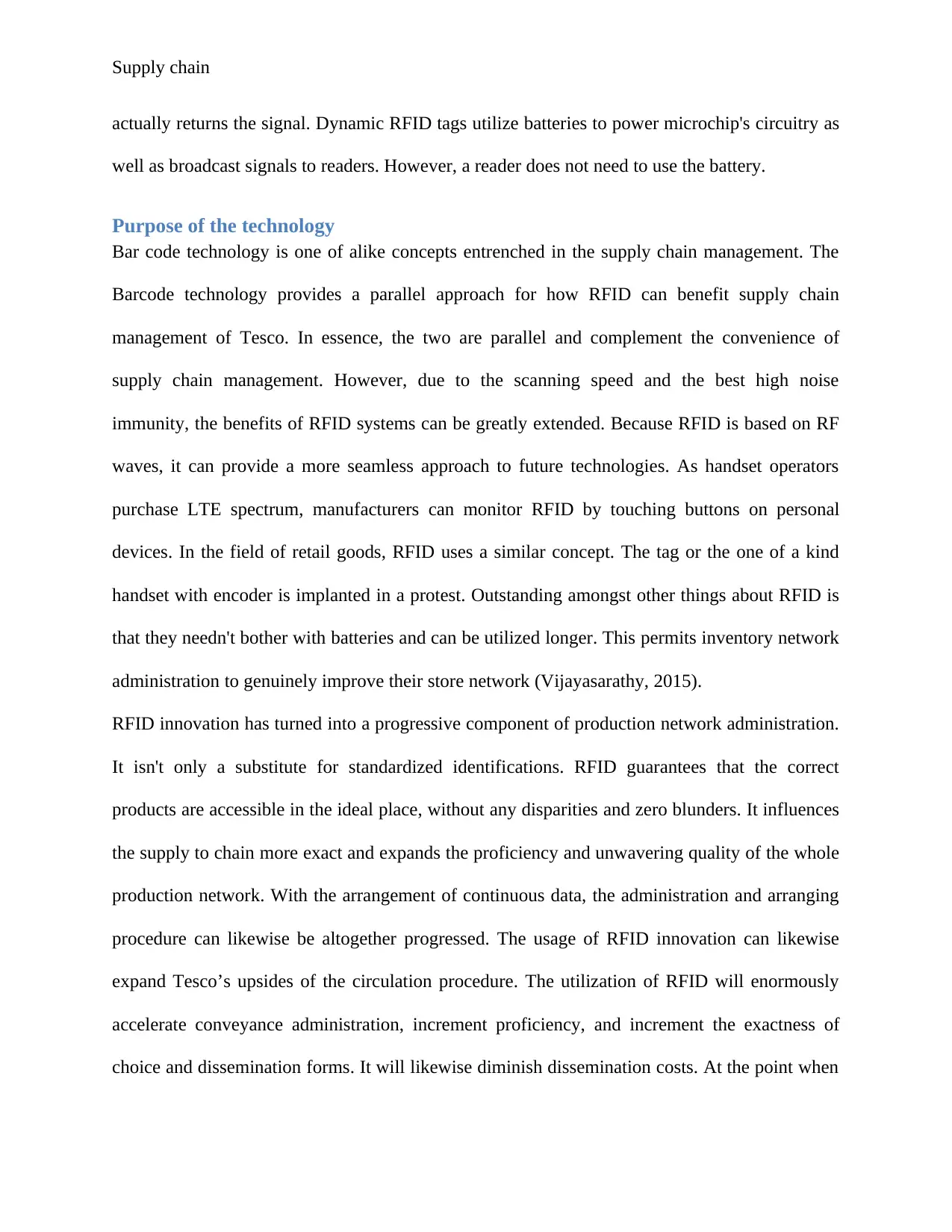
Supply chain
actually returns the signal. Dynamic RFID tags utilize batteries to power microchip's circuitry as
well as broadcast signals to readers. However, a reader does not need to use the battery.
Purpose of the technology
Bar code technology is one of alike concepts entrenched in the supply chain management. The
Barcode technology provides a parallel approach for how RFID can benefit supply chain
management of Tesco. In essence, the two are parallel and complement the convenience of
supply chain management. However, due to the scanning speed and the best high noise
immunity, the benefits of RFID systems can be greatly extended. Because RFID is based on RF
waves, it can provide a more seamless approach to future technologies. As handset operators
purchase LTE spectrum, manufacturers can monitor RFID by touching buttons on personal
devices. In the field of retail goods, RFID uses a similar concept. The tag or the one of a kind
handset with encoder is implanted in a protest. Outstanding amongst other things about RFID is
that they needn't bother with batteries and can be utilized longer. This permits inventory network
administration to genuinely improve their store network (Vijayasarathy, 2015).
RFID innovation has turned into a progressive component of production network administration.
It isn't only a substitute for standardized identifications. RFID guarantees that the correct
products are accessible in the ideal place, without any disparities and zero blunders. It influences
the supply to chain more exact and expands the proficiency and unwavering quality of the whole
production network. With the arrangement of continuous data, the administration and arranging
procedure can likewise be altogether progressed. The usage of RFID innovation can likewise
expand Tesco’s upsides of the circulation procedure. The utilization of RFID will enormously
accelerate conveyance administration, increment proficiency, and increment the exactness of
choice and dissemination forms. It will likewise diminish dissemination costs. At the point when
actually returns the signal. Dynamic RFID tags utilize batteries to power microchip's circuitry as
well as broadcast signals to readers. However, a reader does not need to use the battery.
Purpose of the technology
Bar code technology is one of alike concepts entrenched in the supply chain management. The
Barcode technology provides a parallel approach for how RFID can benefit supply chain
management of Tesco. In essence, the two are parallel and complement the convenience of
supply chain management. However, due to the scanning speed and the best high noise
immunity, the benefits of RFID systems can be greatly extended. Because RFID is based on RF
waves, it can provide a more seamless approach to future technologies. As handset operators
purchase LTE spectrum, manufacturers can monitor RFID by touching buttons on personal
devices. In the field of retail goods, RFID uses a similar concept. The tag or the one of a kind
handset with encoder is implanted in a protest. Outstanding amongst other things about RFID is
that they needn't bother with batteries and can be utilized longer. This permits inventory network
administration to genuinely improve their store network (Vijayasarathy, 2015).
RFID innovation has turned into a progressive component of production network administration.
It isn't only a substitute for standardized identifications. RFID guarantees that the correct
products are accessible in the ideal place, without any disparities and zero blunders. It influences
the supply to chain more exact and expands the proficiency and unwavering quality of the whole
production network. With the arrangement of continuous data, the administration and arranging
procedure can likewise be altogether progressed. The usage of RFID innovation can likewise
expand Tesco’s upsides of the circulation procedure. The utilization of RFID will enormously
accelerate conveyance administration, increment proficiency, and increment the exactness of
choice and dissemination forms. It will likewise diminish dissemination costs. At the point when
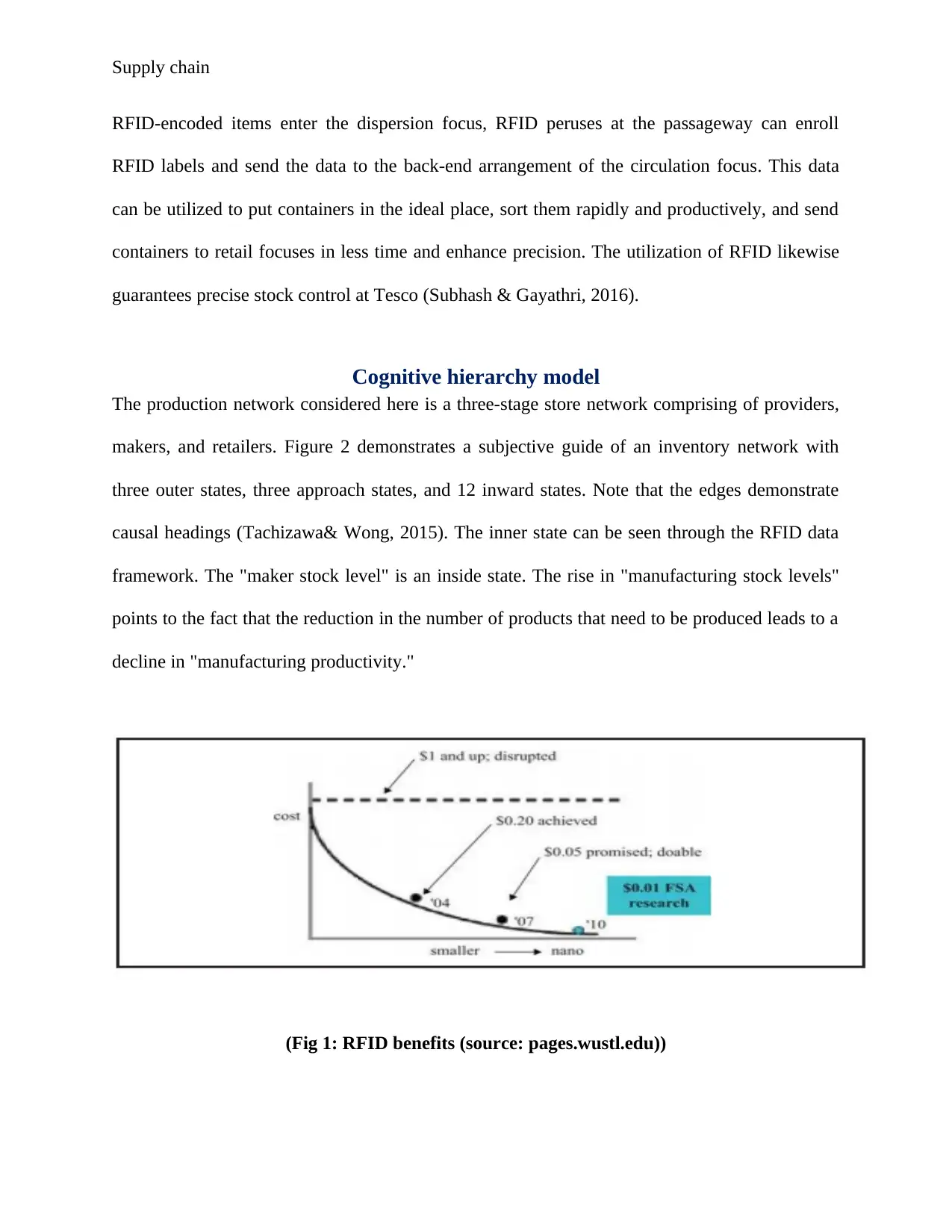
Supply chain
RFID-encoded items enter the dispersion focus, RFID peruses at the passageway can enroll
RFID labels and send the data to the back-end arrangement of the circulation focus. This data
can be utilized to put containers in the ideal place, sort them rapidly and productively, and send
containers to retail focuses in less time and enhance precision. The utilization of RFID likewise
guarantees precise stock control at Tesco (Subhash & Gayathri, 2016).
Cognitive hierarchy model
The production network considered here is a three-stage store network comprising of providers,
makers, and retailers. Figure 2 demonstrates a subjective guide of an inventory network with
three outer states, three approach states, and 12 inward states. Note that the edges demonstrate
causal headings (Tachizawa& Wong, 2015). The inner state can be seen through the RFID data
framework. The "maker stock level" is an inside state. The rise in "manufacturing stock levels"
points to the fact that the reduction in the number of products that need to be produced leads to a
decline in "manufacturing productivity."
(Fig 1: RFID benefits (source: pages.wustl.edu))
RFID-encoded items enter the dispersion focus, RFID peruses at the passageway can enroll
RFID labels and send the data to the back-end arrangement of the circulation focus. This data
can be utilized to put containers in the ideal place, sort them rapidly and productively, and send
containers to retail focuses in less time and enhance precision. The utilization of RFID likewise
guarantees precise stock control at Tesco (Subhash & Gayathri, 2016).
Cognitive hierarchy model
The production network considered here is a three-stage store network comprising of providers,
makers, and retailers. Figure 2 demonstrates a subjective guide of an inventory network with
three outer states, three approach states, and 12 inward states. Note that the edges demonstrate
causal headings (Tachizawa& Wong, 2015). The inner state can be seen through the RFID data
framework. The "maker stock level" is an inside state. The rise in "manufacturing stock levels"
points to the fact that the reduction in the number of products that need to be produced leads to a
decline in "manufacturing productivity."
(Fig 1: RFID benefits (source: pages.wustl.edu))
⊘ This is a preview!⊘
Do you want full access?
Subscribe today to unlock all pages.

Trusted by 1+ million students worldwide

Supply chain
(Figure 2: Cognitive hierarchy model (source: pages.wustl.edu))
How data is used
The retail business utilizes RFID innovation as an innovation that can roll out a genuine
improvement to the way retailers work together, on the grounds that RFID can influence each
part of the store network. RFID has numerous points of interest over standardized tags (Mahalik
& Patel, 2015). The principle preferences of RFID incorporate its remarkable capacity to impart
data to business accomplices, permitting joint effort in stock administration, arranging,
estimating and recharging to call attention to that RFID can convey numerous advantages to
retailers, including: improving the sales tier, planning needs Style, size and color, as well as sales
(Figure 2: Cognitive hierarchy model (source: pages.wustl.edu))
How data is used
The retail business utilizes RFID innovation as an innovation that can roll out a genuine
improvement to the way retailers work together, on the grounds that RFID can influence each
part of the store network. RFID has numerous points of interest over standardized tags (Mahalik
& Patel, 2015). The principle preferences of RFID incorporate its remarkable capacity to impart
data to business accomplices, permitting joint effort in stock administration, arranging,
estimating and recharging to call attention to that RFID can convey numerous advantages to
retailers, including: improving the sales tier, planning needs Style, size and color, as well as sales
Paraphrase This Document
Need a fresh take? Get an instant paraphrase of this document with our AI Paraphraser
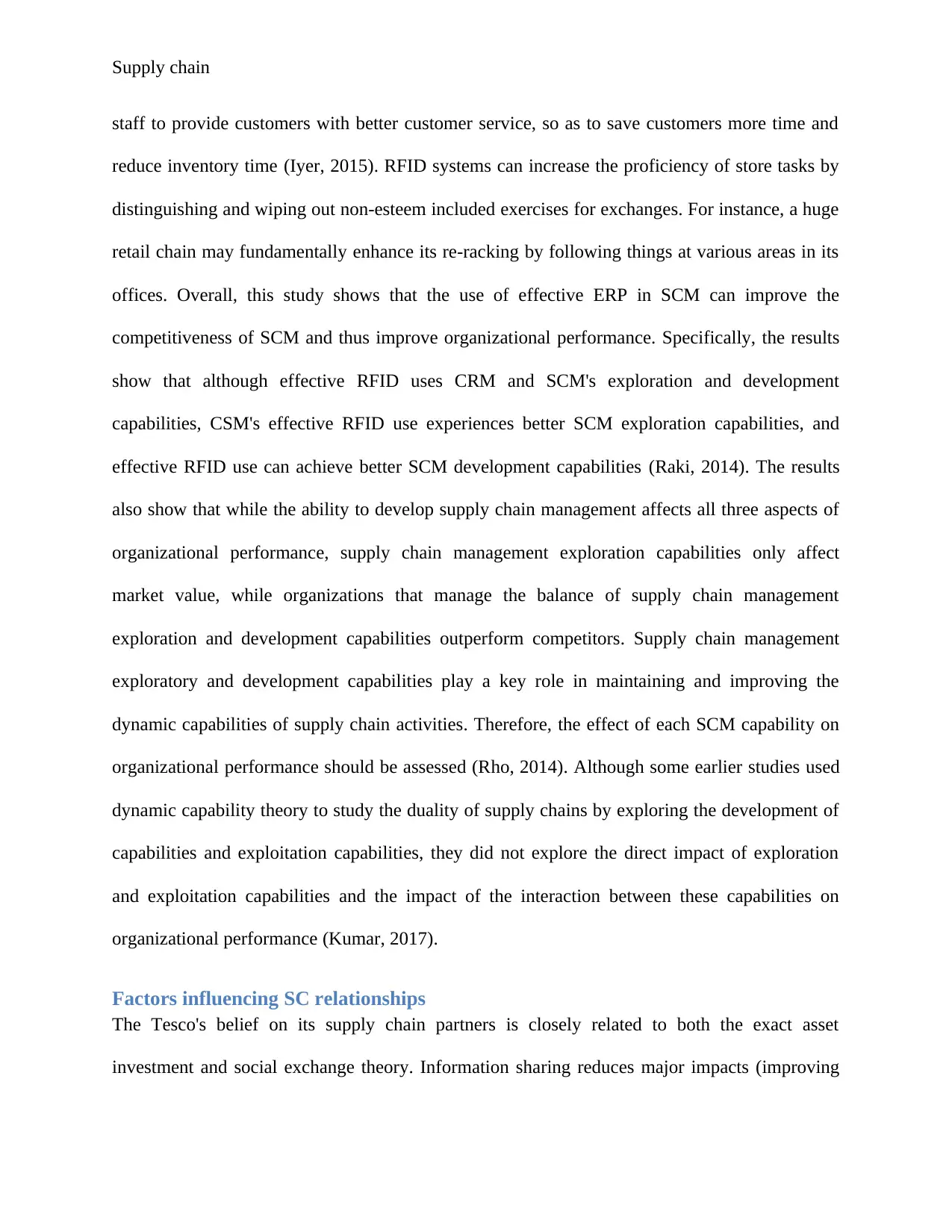
Supply chain
staff to provide customers with better customer service, so as to save customers more time and
reduce inventory time (Iyer, 2015). RFID systems can increase the proficiency of store tasks by
distinguishing and wiping out non-esteem included exercises for exchanges. For instance, a huge
retail chain may fundamentally enhance its re-racking by following things at various areas in its
offices. Overall, this study shows that the use of effective ERP in SCM can improve the
competitiveness of SCM and thus improve organizational performance. Specifically, the results
show that although effective RFID uses CRM and SCM's exploration and development
capabilities, CSM's effective RFID use experiences better SCM exploration capabilities, and
effective RFID use can achieve better SCM development capabilities (Raki, 2014). The results
also show that while the ability to develop supply chain management affects all three aspects of
organizational performance, supply chain management exploration capabilities only affect
market value, while organizations that manage the balance of supply chain management
exploration and development capabilities outperform competitors. Supply chain management
exploratory and development capabilities play a key role in maintaining and improving the
dynamic capabilities of supply chain activities. Therefore, the effect of each SCM capability on
organizational performance should be assessed (Rho, 2014). Although some earlier studies used
dynamic capability theory to study the duality of supply chains by exploring the development of
capabilities and exploitation capabilities, they did not explore the direct impact of exploration
and exploitation capabilities and the impact of the interaction between these capabilities on
organizational performance (Kumar, 2017).
Factors influencing SC relationships
The Tesco's belief on its supply chain partners is closely related to both the exact asset
investment and social exchange theory. Information sharing reduces major impacts (improving
staff to provide customers with better customer service, so as to save customers more time and
reduce inventory time (Iyer, 2015). RFID systems can increase the proficiency of store tasks by
distinguishing and wiping out non-esteem included exercises for exchanges. For instance, a huge
retail chain may fundamentally enhance its re-racking by following things at various areas in its
offices. Overall, this study shows that the use of effective ERP in SCM can improve the
competitiveness of SCM and thus improve organizational performance. Specifically, the results
show that although effective RFID uses CRM and SCM's exploration and development
capabilities, CSM's effective RFID use experiences better SCM exploration capabilities, and
effective RFID use can achieve better SCM development capabilities (Raki, 2014). The results
also show that while the ability to develop supply chain management affects all three aspects of
organizational performance, supply chain management exploration capabilities only affect
market value, while organizations that manage the balance of supply chain management
exploration and development capabilities outperform competitors. Supply chain management
exploratory and development capabilities play a key role in maintaining and improving the
dynamic capabilities of supply chain activities. Therefore, the effect of each SCM capability on
organizational performance should be assessed (Rho, 2014). Although some earlier studies used
dynamic capability theory to study the duality of supply chains by exploring the development of
capabilities and exploitation capabilities, they did not explore the direct impact of exploration
and exploitation capabilities and the impact of the interaction between these capabilities on
organizational performance (Kumar, 2017).
Factors influencing SC relationships
The Tesco's belief on its supply chain partners is closely related to both the exact asset
investment and social exchange theory. Information sharing reduces major impacts (improving
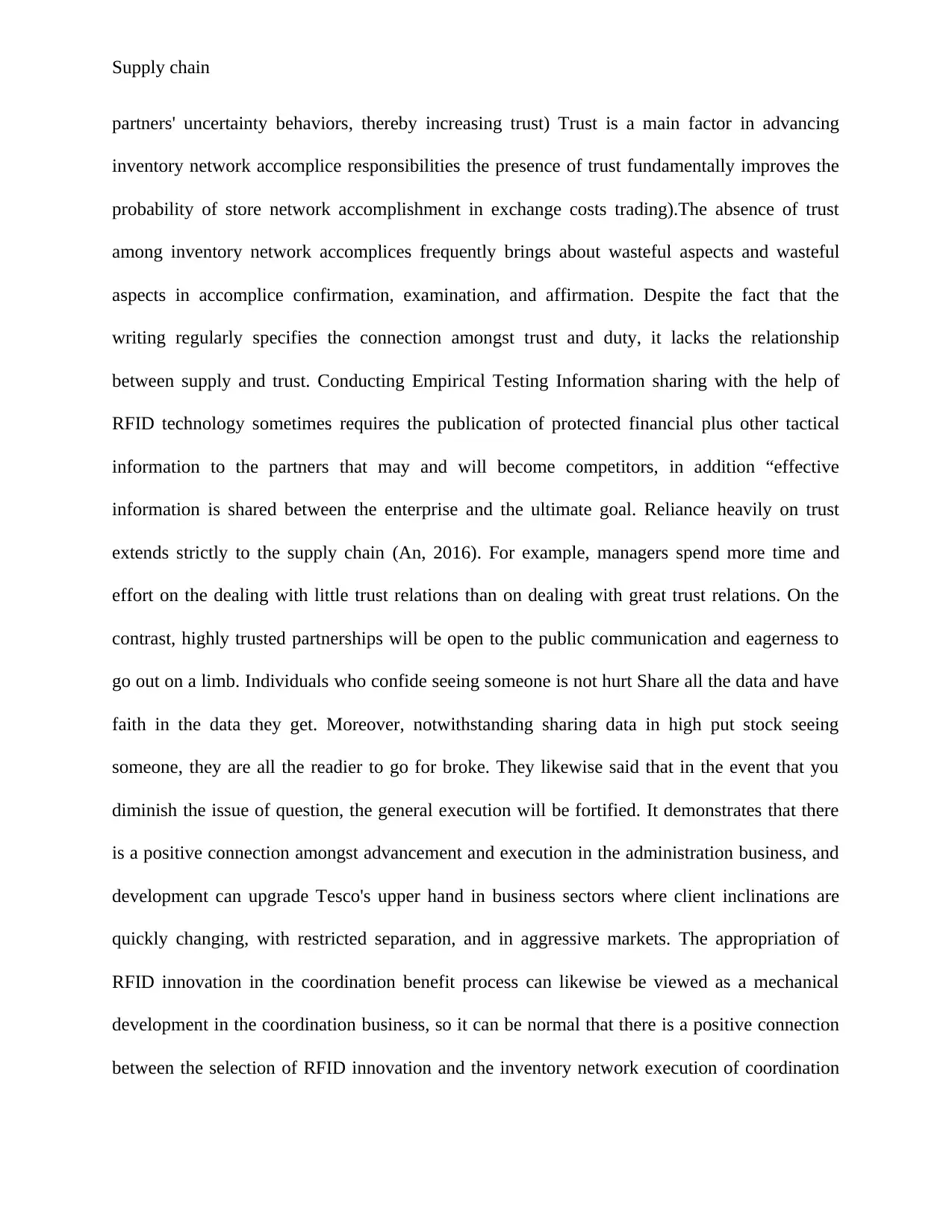
Supply chain
partners' uncertainty behaviors, thereby increasing trust) Trust is a main factor in advancing
inventory network accomplice responsibilities the presence of trust fundamentally improves the
probability of store network accomplishment in exchange costs trading).The absence of trust
among inventory network accomplices frequently brings about wasteful aspects and wasteful
aspects in accomplice confirmation, examination, and affirmation. Despite the fact that the
writing regularly specifies the connection amongst trust and duty, it lacks the relationship
between supply and trust. Conducting Empirical Testing Information sharing with the help of
RFID technology sometimes requires the publication of protected financial plus other tactical
information to the partners that may and will become competitors, in addition “effective
information is shared between the enterprise and the ultimate goal. Reliance heavily on trust
extends strictly to the supply chain (An, 2016). For example, managers spend more time and
effort on the dealing with little trust relations than on dealing with great trust relations. On the
contrast, highly trusted partnerships will be open to the public communication and eagerness to
go out on a limb. Individuals who confide seeing someone is not hurt Share all the data and have
faith in the data they get. Moreover, notwithstanding sharing data in high put stock seeing
someone, they are all the readier to go for broke. They likewise said that in the event that you
diminish the issue of question, the general execution will be fortified. It demonstrates that there
is a positive connection amongst advancement and execution in the administration business, and
development can upgrade Tesco's upper hand in business sectors where client inclinations are
quickly changing, with restricted separation, and in aggressive markets. The appropriation of
RFID innovation in the coordination benefit process can likewise be viewed as a mechanical
development in the coordination business, so it can be normal that there is a positive connection
between the selection of RFID innovation and the inventory network execution of coordination
partners' uncertainty behaviors, thereby increasing trust) Trust is a main factor in advancing
inventory network accomplice responsibilities the presence of trust fundamentally improves the
probability of store network accomplishment in exchange costs trading).The absence of trust
among inventory network accomplices frequently brings about wasteful aspects and wasteful
aspects in accomplice confirmation, examination, and affirmation. Despite the fact that the
writing regularly specifies the connection amongst trust and duty, it lacks the relationship
between supply and trust. Conducting Empirical Testing Information sharing with the help of
RFID technology sometimes requires the publication of protected financial plus other tactical
information to the partners that may and will become competitors, in addition “effective
information is shared between the enterprise and the ultimate goal. Reliance heavily on trust
extends strictly to the supply chain (An, 2016). For example, managers spend more time and
effort on the dealing with little trust relations than on dealing with great trust relations. On the
contrast, highly trusted partnerships will be open to the public communication and eagerness to
go out on a limb. Individuals who confide seeing someone is not hurt Share all the data and have
faith in the data they get. Moreover, notwithstanding sharing data in high put stock seeing
someone, they are all the readier to go for broke. They likewise said that in the event that you
diminish the issue of question, the general execution will be fortified. It demonstrates that there
is a positive connection amongst advancement and execution in the administration business, and
development can upgrade Tesco's upper hand in business sectors where client inclinations are
quickly changing, with restricted separation, and in aggressive markets. The appropriation of
RFID innovation in the coordination benefit process can likewise be viewed as a mechanical
development in the coordination business, so it can be normal that there is a positive connection
between the selection of RFID innovation and the inventory network execution of coordination
⊘ This is a preview!⊘
Do you want full access?
Subscribe today to unlock all pages.

Trusted by 1+ million students worldwide
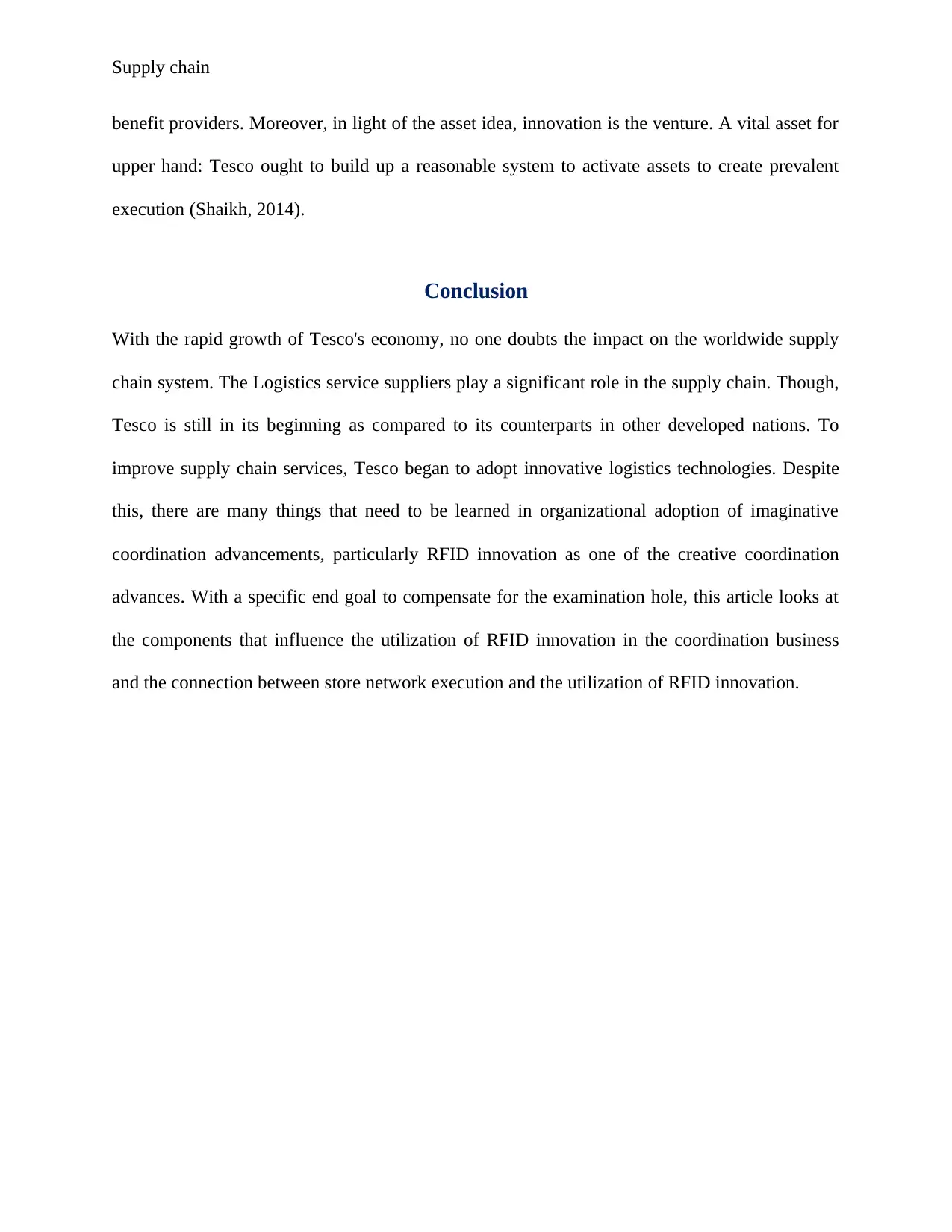
Supply chain
benefit providers. Moreover, in light of the asset idea, innovation is the venture. A vital asset for
upper hand: Tesco ought to build up a reasonable system to activate assets to create prevalent
execution (Shaikh, 2014).
Conclusion
With the rapid growth of Tesco's economy, no one doubts the impact on the worldwide supply
chain system. The Logistics service suppliers play a significant role in the supply chain. Though,
Tesco is still in its beginning as compared to its counterparts in other developed nations. To
improve supply chain services, Tesco began to adopt innovative logistics technologies. Despite
this, there are many things that need to be learned in organizational adoption of imaginative
coordination advancements, particularly RFID innovation as one of the creative coordination
advances. With a specific end goal to compensate for the examination hole, this article looks at
the components that influence the utilization of RFID innovation in the coordination business
and the connection between store network execution and the utilization of RFID innovation.
benefit providers. Moreover, in light of the asset idea, innovation is the venture. A vital asset for
upper hand: Tesco ought to build up a reasonable system to activate assets to create prevalent
execution (Shaikh, 2014).
Conclusion
With the rapid growth of Tesco's economy, no one doubts the impact on the worldwide supply
chain system. The Logistics service suppliers play a significant role in the supply chain. Though,
Tesco is still in its beginning as compared to its counterparts in other developed nations. To
improve supply chain services, Tesco began to adopt innovative logistics technologies. Despite
this, there are many things that need to be learned in organizational adoption of imaginative
coordination advancements, particularly RFID innovation as one of the creative coordination
advances. With a specific end goal to compensate for the examination hole, this article looks at
the components that influence the utilization of RFID innovation in the coordination business
and the connection between store network execution and the utilization of RFID innovation.
Paraphrase This Document
Need a fresh take? Get an instant paraphrase of this document with our AI Paraphraser
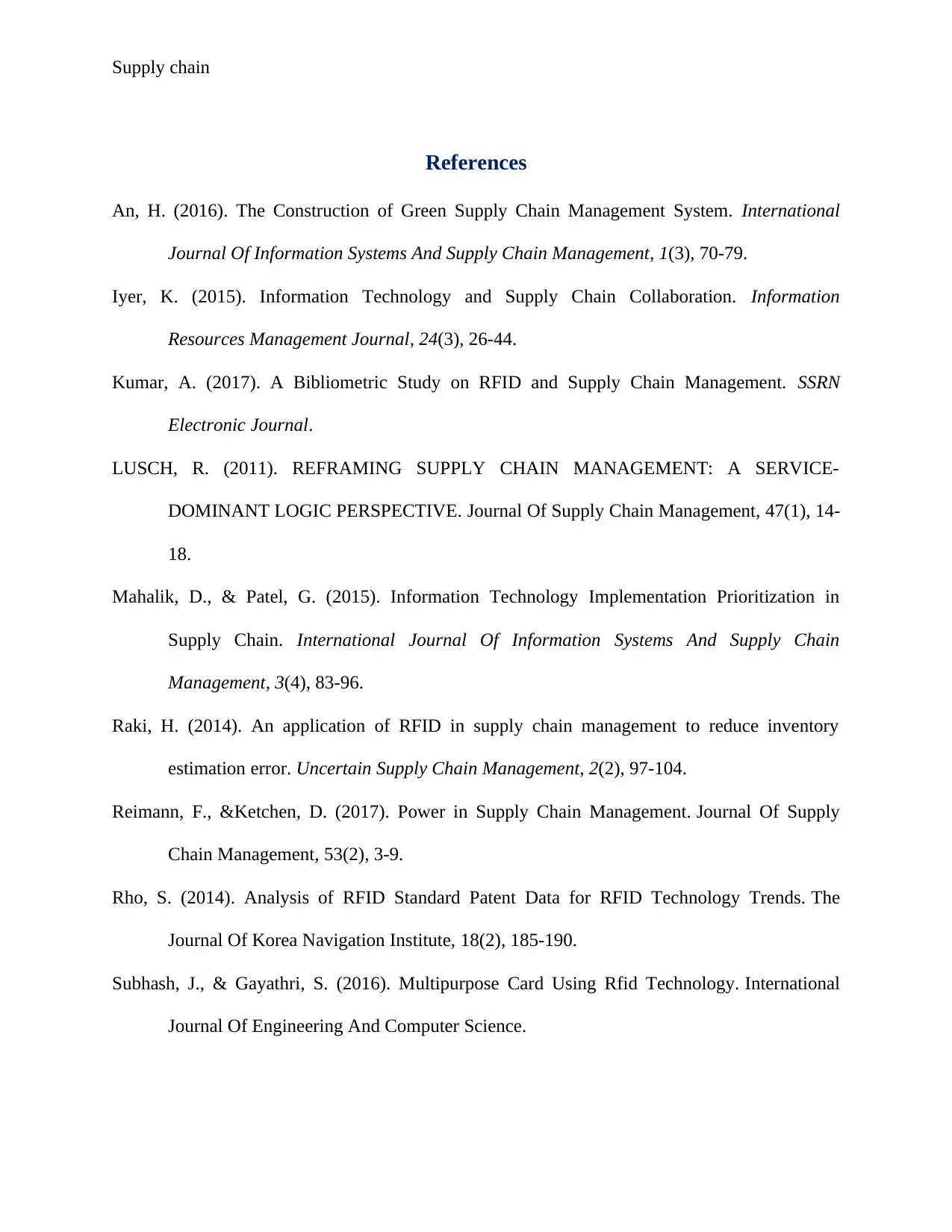
Supply chain
References
An, H. (2016). The Construction of Green Supply Chain Management System. International
Journal Of Information Systems And Supply Chain Management, 1(3), 70-79.
Iyer, K. (2015). Information Technology and Supply Chain Collaboration. Information
Resources Management Journal, 24(3), 26-44.
Kumar, A. (2017). A Bibliometric Study on RFID and Supply Chain Management. SSRN
Electronic Journal.
LUSCH, R. (2011). REFRAMING SUPPLY CHAIN MANAGEMENT: A SERVICE-
DOMINANT LOGIC PERSPECTIVE. Journal Of Supply Chain Management, 47(1), 14-
18.
Mahalik, D., & Patel, G. (2015). Information Technology Implementation Prioritization in
Supply Chain. International Journal Of Information Systems And Supply Chain
Management, 3(4), 83-96.
Raki, H. (2014). An application of RFID in supply chain management to reduce inventory
estimation error. Uncertain Supply Chain Management, 2(2), 97-104.
Reimann, F., &Ketchen, D. (2017). Power in Supply Chain Management. Journal Of Supply
Chain Management, 53(2), 3-9.
Rho, S. (2014). Analysis of RFID Standard Patent Data for RFID Technology Trends. The
Journal Of Korea Navigation Institute, 18(2), 185-190.
Subhash, J., & Gayathri, S. (2016). Multipurpose Card Using Rfid Technology. International
Journal Of Engineering And Computer Science.
References
An, H. (2016). The Construction of Green Supply Chain Management System. International
Journal Of Information Systems And Supply Chain Management, 1(3), 70-79.
Iyer, K. (2015). Information Technology and Supply Chain Collaboration. Information
Resources Management Journal, 24(3), 26-44.
Kumar, A. (2017). A Bibliometric Study on RFID and Supply Chain Management. SSRN
Electronic Journal.
LUSCH, R. (2011). REFRAMING SUPPLY CHAIN MANAGEMENT: A SERVICE-
DOMINANT LOGIC PERSPECTIVE. Journal Of Supply Chain Management, 47(1), 14-
18.
Mahalik, D., & Patel, G. (2015). Information Technology Implementation Prioritization in
Supply Chain. International Journal Of Information Systems And Supply Chain
Management, 3(4), 83-96.
Raki, H. (2014). An application of RFID in supply chain management to reduce inventory
estimation error. Uncertain Supply Chain Management, 2(2), 97-104.
Reimann, F., &Ketchen, D. (2017). Power in Supply Chain Management. Journal Of Supply
Chain Management, 53(2), 3-9.
Rho, S. (2014). Analysis of RFID Standard Patent Data for RFID Technology Trends. The
Journal Of Korea Navigation Institute, 18(2), 185-190.
Subhash, J., & Gayathri, S. (2016). Multipurpose Card Using Rfid Technology. International
Journal Of Engineering And Computer Science.

Supply chain
Shaikh, A. (2014). The Role of RFID in Supply Chain Management Macro Processes.
International Journal Of Innovation, Management And Technology.
Tachizawa, E., & Wong, C. (2015). The Performance of Green Supply Chain Management
Governance Mechanisms: A Supply Network and Complexity Perspective. Journal Of
Supply Chain Management, 51(3), 18-32.
Vijayasarathy, L. (2010). An investigation of moderators of the link between technology use in
the supply chain and supply chain performance. Information & Management, 47(7-8),
364-371.
Shaikh, A. (2014). The Role of RFID in Supply Chain Management Macro Processes.
International Journal Of Innovation, Management And Technology.
Tachizawa, E., & Wong, C. (2015). The Performance of Green Supply Chain Management
Governance Mechanisms: A Supply Network and Complexity Perspective. Journal Of
Supply Chain Management, 51(3), 18-32.
Vijayasarathy, L. (2010). An investigation of moderators of the link between technology use in
the supply chain and supply chain performance. Information & Management, 47(7-8),
364-371.
⊘ This is a preview!⊘
Do you want full access?
Subscribe today to unlock all pages.

Trusted by 1+ million students worldwide
1 out of 12
Related Documents
Your All-in-One AI-Powered Toolkit for Academic Success.
+13062052269
info@desklib.com
Available 24*7 on WhatsApp / Email
![[object Object]](/_next/static/media/star-bottom.7253800d.svg)
Unlock your academic potential
Copyright © 2020–2025 A2Z Services. All Rights Reserved. Developed and managed by ZUCOL.




